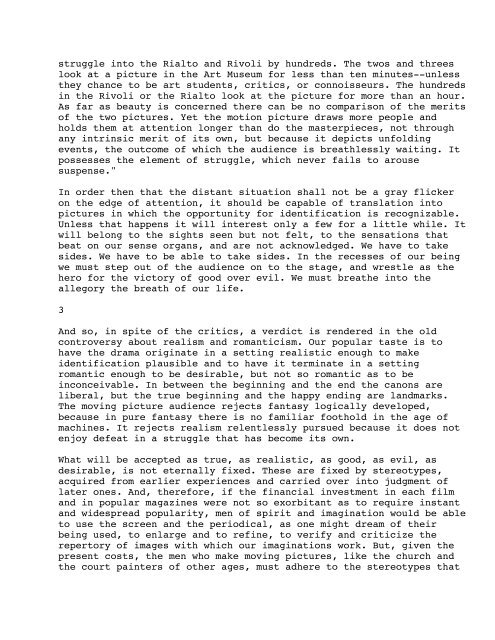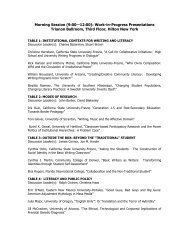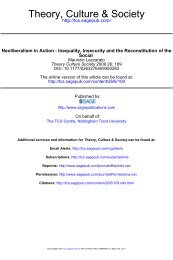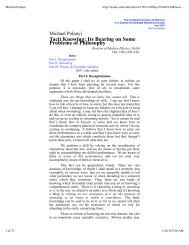PUBLIC OPINION by WALTER LIPPMANN TO FAYE LIPPMANN ...
PUBLIC OPINION by WALTER LIPPMANN TO FAYE LIPPMANN ...
PUBLIC OPINION by WALTER LIPPMANN TO FAYE LIPPMANN ...
You also want an ePaper? Increase the reach of your titles
YUMPU automatically turns print PDFs into web optimized ePapers that Google loves.
struggle into the Rialto and Rivoli <strong>by</strong> hundreds. The twos and threes<br />
look at a picture in the Art Museum for less than ten minutes--unless<br />
they chance to be art students, critics, or connoisseurs. The hundreds<br />
in the Rivoli or the Rialto look at the picture for more than an hour.<br />
As far as beauty is concerned there can be no comparison of the merits<br />
of the two pictures. Yet the motion picture draws more people and<br />
holds them at attention longer than do the masterpieces, not through<br />
any intrinsic merit of its own, but because it depicts unfolding<br />
events, the outcome of which the audience is breathlessly waiting. It<br />
possesses the element of struggle, which never fails to arouse<br />
suspense."<br />
In order then that the distant situation shall not be a gray flicker<br />
on the edge of attention, it should be capable of translation into<br />
pictures in which the opportunity for identification is recognizable.<br />
Unless that happens it will interest only a few for a little while. It<br />
will belong to the sights seen but not felt, to the sensations that<br />
beat on our sense organs, and are not acknowledged. We have to take<br />
sides. We have to be able to take sides. In the recesses of our being<br />
we must step out of the audience on to the stage, and wrestle as the<br />
hero for the victory of good over evil. We must breathe into the<br />
allegory the breath of our life.<br />
3<br />
And so, in spite of the critics, a verdict is rendered in the old<br />
controversy about realism and romanticism. Our popular taste is to<br />
have the drama originate in a setting realistic enough to make<br />
identification plausible and to have it terminate in a setting<br />
romantic enough to be desirable, but not so romantic as to be<br />
inconceivable. In between the beginning and the end the canons are<br />
liberal, but the true beginning and the happy ending are landmarks.<br />
The moving picture audience rejects fantasy logically developed,<br />
because in pure fantasy there is no familiar foothold in the age of<br />
machines. It rejects realism relentlessly pursued because it does not<br />
enjoy defeat in a struggle that has become its own.<br />
What will be accepted as true, as realistic, as good, as evil, as<br />
desirable, is not eternally fixed. These are fixed <strong>by</strong> stereotypes,<br />
acquired from earlier experiences and carried over into judgment of<br />
later ones. And, therefore, if the financial investment in each film<br />
and in popular magazines were not so exorbitant as to require instant<br />
and widespread popularity, men of spirit and imagination would be able<br />
to use the screen and the periodical, as one might dream of their<br />
being used, to enlarge and to refine, to verify and criticize the<br />
repertory of images with which our imaginations work. But, given the<br />
present costs, the men who make moving pictures, like the church and<br />
the court painters of other ages, must adhere to the stereotypes that





